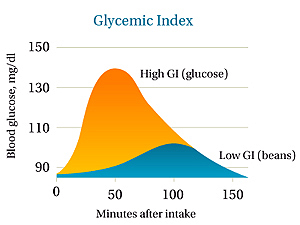September 27, 2010
The Glycemic Index And Diabetes

By Michael D. Shaw
Since the gold standard symptom of diabetes is having a blood sugar level higher than established “normal” values, diabetics have long been hung up on sugar, and thus carbohydrates. However, as you will see, obsessing on one aspect of the diet is seldom a healthy course of action.
At first blush, a low carb diet would seem to be indicated, and these have been popular (at least short-term) with some diabetics. As it happens, such a diet will lower blood glucose, but creates other problems. For one thing, after the desired weight loss (if any) is achieved, the calories from those lost carbs are going to have be made up with fat and protein.
But, diabetics are only too aware that their kidneys and heart are at risk with this disease. High protein is hard on your kidneys, and high fat is bad for your heart. And this just scratches the surface with what’s wrong with low carb. There is plenty of literature suggesting that the ability of insulin to lower blood sugar is improved by eating carbohydrates, including an oft-cited classic paper on diabetes from 1936. Likewise, many authorities believe that fats promote insulin resistance, thus elevating blood sugar.
Notably, the many studies extant that demonstrate how a low carb diet will lower blood sugar are virtually all short-term. That’s because most people can’t stay on a low carb diet for very long, for a host of reasons. Moreover, the low carb craze deliberately ignores that some of the world’s healthiest populations—in terms of frequency of the major “killer” diseases including diabetes—exist on high carb diets.
Perhaps we should consider the quality of the carbs we consume. Fair enough, which brings us to the Glycemic Index.
The glycemic index (GI) is a ranking of carbohydrates on a scale from 0 to 100 according to the extent to which they raise blood sugar levels after eating. Foods with a high GI are those which are rapidly digested and absorbed and result in marked fluctuations in blood sugar levels.
Measured portions of individual foods are fed to ten non-diabetic participants who have fasted overnight, and their blood glucose levels are logged for two hours. The averaged data is plotted on a curve, and the area under the curve (AUC) for the test food is divided by the AUC for the reference food (glucose). This ratio (multiplied by 100) becomes the GI. The implication is that the lower the GI, the better, and that a low GI diet is a healthy diet. A GI database is available online.
Low GI is 0-55 ; Moderate GI is 56-69; High GI is 70 or more. Let’s look at the database to see if low glycemic is always healthier.
Numerous chocolate candies show up in the 20’s. Ice cream and chocolate cake are in the 30’s. Compare this to brown rice at 66 or 87 (both values are shown, and reflect data from different labs). Anyone think candy and ice cream are healthier than brown rice?
Those lower GI numbers simply reflect the fat content. Fat and protein slow down gastric emptying, and thus slow down digestion of carbohydrates. Likewise, the lowest GI for a baked potato (skin on) is 69, compared to 54 for the lowest French fries, and 55 for potato chips. Ironically, GI diet proponents condemn low carb/no carb diets because they add too much fat!
Beyond this, GI is affected by the ripeness of the food item, as well as its storage temperature, and how it is cooked.
But the biggest fallacy is that testing foods in isolation bears no resemblance to real life. In real life, foods are mixed during a meal, and there will likely be some fat mixed in with that bite of a carbohydrate food, thus lowering its GI. For this reason alone, any attempt at maintaining a low GI diet using the standard data is little more than a fool’s errand.
Finally, since the GI numbers for many simple sugars—including fructose at 23—are quite low, you could construct a low GI diet that was actually very high in sugar content. What diabetic (or anyone interested in good health) would do that?
Certainly, there are healthy foods with a low GI—for example, most fruits, vegetables, and legumes—but so what? You already knew about them.
My best advice, whether you are diabetic or not, is to avoid fad diets.

